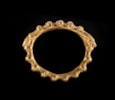Ibex Headed Bracelet
This highly decorative gold bracelet is made of a moulded ribbed design, the ends terminate in what can be presumed to be ibex heads. With their long horns clearly defined and lying flat to their heads. The main body of the bracelet is created from alternating ribbed and beaded sections. Also known as the First Persian Empire, the Achaemenid Empire ruled through vast swathes of western Asia between 550-330 B.C. Founded by Cyrus the Great, the empire spanned from the Mediterranean Sea to the Indus River, encompassing all the civilised states of the ancient Near East. The later king Darius I expanded the empire further into Northern Africa, Europe, the Middle East and Asia. This new massive empire established a civic service, official language, road system, postal service and constructed the Mausoleum of Halicarnassus, one of the ancient Seven Wonders of the World. Their material culture ranged from monumental structures to fine metal goods and was a hybrid of Median, Asiatic, Greek and Assyrian influences, yet maintained a distinctly Persian identity. It was under the prestigious reign of Darius (522-486 B.C.) that it acquired its "Court Style" and formalised shapes and stylistic attributes. In this period, the decoration of jewellery was inspired by the world of animals and was an imitation of Mesopotamian art. It is evident from that most of the Achaemenid jewellery bears animal motifs indicating the position and importance of each; this is manifested through a symbolic concept which can be observed in the artworks of the era. Animals with prowess or of high importance in the natural world, including the lion, ibex, boar, calf, and falcon were used repeatedly. Also, mythological creatures with such as the griffon can often be found. For these ancient people, the ibex had a mythological importance and a symbolic and sacred role. Among Iranian people and civilizations, and in the different arts, an ibex with long horns indicated its symbolic role and was considered to be a symbol of water, rain, abundance and blessings, as well as of the guardian of the moon. In many cultures, the ibex is considered to be a symbol of fertility and blessing. Similar examples of this bracelet can be found in the Oxus treasure kept at the British Museum.
Trésors de L'ancien Iran, Musée Rath, Geneva, 8 June-25 September 1966, p.117, no. 640, pl. 51-52.
Ancient Jewellery, Antiquities, Gold Medallions and Coins, Christie’s, London, Monday 19 October, 1970, lot 71, illus.
David Aaron Ltd, 2021, No.18.
Previously in the Private Collection of Mr Sami Choucair (1923-1976), prior to 1966.
With Jean-Philippe Mariaud de Serres (1944-2007), Paris.
New York art market, 2006, acquired from the above, 2006
With David Aaron, 2006
Private Collection, France, acquired from the above on 21st July 2006 (accompanied by French cultural passport 218819).
ALR: S00202560, with IADDA Certificate, this item has been checked against the Interpol database.










 Enquire
Enquire




